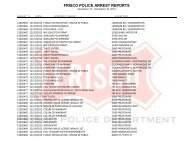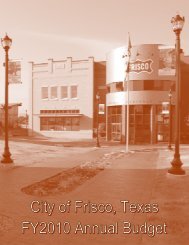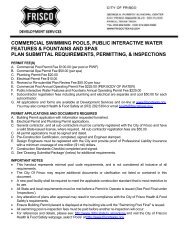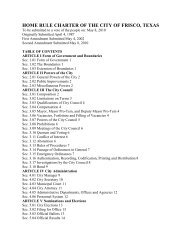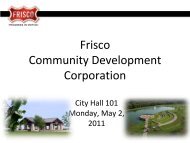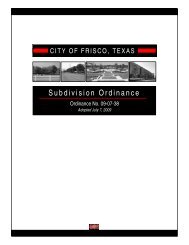Modern Roundabout Feasibility Study - City of Frisco
Modern Roundabout Feasibility Study - City of Frisco
Modern Roundabout Feasibility Study - City of Frisco
Create successful ePaper yourself
Turn your PDF publications into a flip-book with our unique Google optimized e-Paper software.
OHIO DRIVE ROUNDABOUT FEASIBILITY STUDY, CITY OF FRISCO<br />
3.0 CAPACITY AND LEVEL OF SERVICE ANALYSIS<br />
3.1 LOS Concepts<br />
The operations <strong>of</strong> the study intersections can be measured in terms <strong>of</strong> their levels <strong>of</strong> service<br />
(LOS), a value that represents the operating conditions that may occur on a roadway or at an<br />
intersection when accommodating various levels <strong>of</strong> traffic volumes. It is a qualitative measure<br />
responsive to the effects <strong>of</strong> a number <strong>of</strong> operational factors such as intersection geometry, traffic<br />
signal control parameters, traffic volume fluctuations, pedestrian activity, and others. In<br />
applying these LOS measurements to an intersection, it is possible to compare the operational<br />
qualities <strong>of</strong> the intersection under different conditions and alternatives.<br />
LOS values range from A, which is characterized by traffic flows under unencumbered free-flow<br />
conditions with little or no delay, to F, which is characterized by traffic flows under stop-and-go<br />
conditions, like peak hour or extreme congestion. The intermediate levels <strong>of</strong> service reflect the<br />
spectrum <strong>of</strong> conditions that exist between levels A and F. LOS B represents a condition with<br />
short delays to traffic. LOS C (average traffic delay) is considered desirable for peak or design<br />
traffic flow. In urban areas LOS D (more significant delays than LOS C) is generally considered<br />
acceptable during peak hour conditions. LOS E indicates that capacity has been reached.<br />
The LOS values are a function <strong>of</strong> vehicle delay as defined in Transportation Research Board’s<br />
Highway Capacity Manual (HCM). The ranges <strong>of</strong> delay and corresponding LOS for both<br />
signalized and unsignalized conditions are outlined in Table 3. According to the HCM, the LOS<br />
criteria for signalized and unsignalized conditions are different primarily because user<br />
perceptions differ among each facility type. The expectation is that a signalized intersection is<br />
designed to carry higher traffic volumes and will present greater delay than an unsignalized<br />
intersection. In addition, unsignalized intersections are associated with more uncertainty and<br />
unpredictable delay for users, which can reduce the user’s tolerance.<br />
LOS<br />
Table 3 - LOS and Control Delay Criteria<br />
Two-way and All-way<br />
Stop Control<br />
(seconds per vehicle)<br />
Signalized Intersection<br />
(seconds per vehicle)<br />
Intersection capacity provides another measure <strong>of</strong> efficiency. Capacity is measured in terms <strong>of</strong><br />
the ratio <strong>of</strong> actual vehicular volume to its available capacity and is an indication <strong>of</strong> the level <strong>of</strong><br />
congestion experienced by each lane group. When the volume-to-capacity (V/C) ratio equals or<br />
exceeds 1.0 the lane group is operating at or above capacity. For the purpose <strong>of</strong> this study,<br />
maximum V/C ratios are reported for the most congested lane group on each approach.<br />
3.2 Highway Capacity Manual V/C Analysis for <strong>Roundabout</strong>s<br />
Chapter 21 <strong>of</strong> the 2010 Highway Capacity Manual provided the guidance in estimating the future<br />
V/C ratios for each <strong>of</strong> the roundabout geometric alternatives. The HCM methodology is based<br />
on regression models developed by studying roundabouts in the U.S. The field data collected<br />
during these studies was used to derive statistical relationships between basic geometric features,<br />
volumes, and capacity. However, from a network standpoint, this methodology does not<br />
consider the effects from adjacent signals or nearby disturbances in the traffic stream. In<br />
addition, the details regarding the size and geometry <strong>of</strong> the roundabout are not taken into<br />
account, nor factors such as gap acceptance to enter the roundabout.<br />
The V/C ratios and levels <strong>of</strong> service (LOS) were estimated for year 2015 (existing) traffic<br />
volumes and projected year 2030 traffic volumes. Chapter 21 <strong>of</strong> the 2010 HCM provided the<br />
detailed methodology for the analyses <strong>of</strong> the proposed roundabouts. The procedures outlined in<br />
the HCM uses a combination <strong>of</strong> regression and analytical models for both single and double-lane<br />
roundabout operations. The required input data includes the lane configuration <strong>of</strong> each approach<br />
to the roundabout, the demand volume for vehicles and pedestrians, and heavy vehicle<br />
percentages.<br />
3.2.1 Analysis Results<br />
Under each analysis year (2015 and 2030), the weekday PM peak hour was analyzed since this<br />
period was found to be the highest volume peak period for the study intersections. Based on the<br />
existing turning movement count data, the AM peak hour volumes ranged between 57% and<br />
68% <strong>of</strong> the PM peak hour volumes. In addition, the Saturday PM peak volumes ranged between<br />
71% and 89% <strong>of</strong> the PM peak hour volumes. Therefore, the Saturday peak hour was also<br />
analyzed as the second highest peak period. Table 4 provides a summary <strong>of</strong> the 2015 capacity<br />
analysis results.<br />
A ≤10 ≤10<br />
B >10 and ≤15 >10 and ≤20<br />
C >15 and ≤25 >20 and ≤35<br />
D >25 and ≤35 >35 and ≤55<br />
E >35 and ≤50 >55 and ≤80<br />
F >50 >80<br />
BROWN & GAY ENGINEERS, INC.<br />
6




